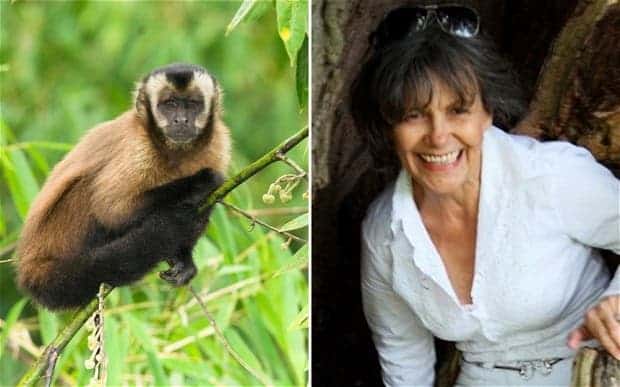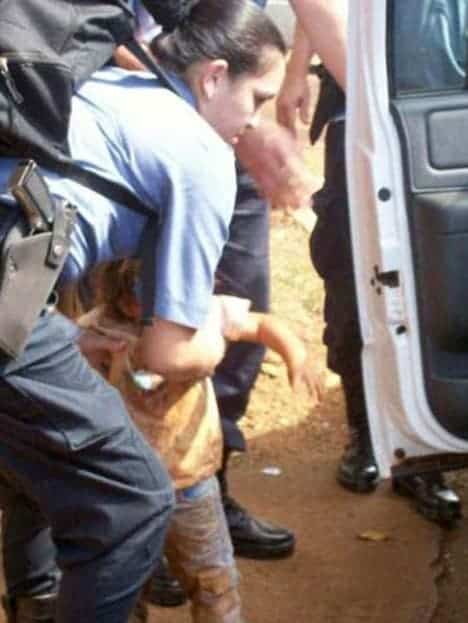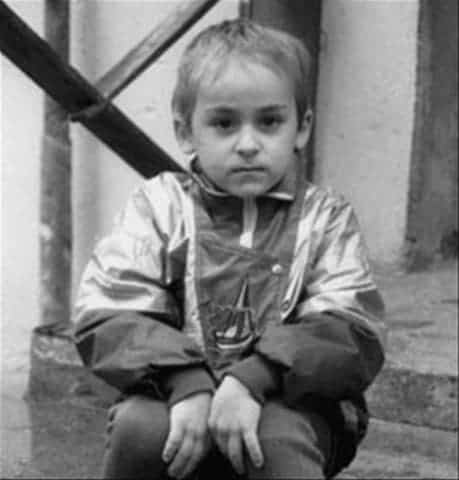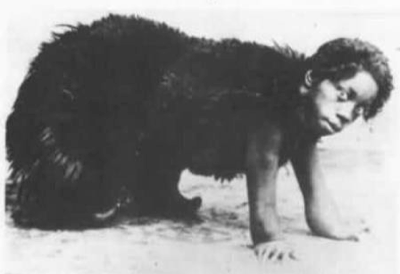We’ve often heard of feral animals, but how often do you hear about feral children? Feral children have been isolated from human contact from a very young age and grow up wild, sometimes being taken care of by animals. In other cases, feral children have been confined by people (usually their own parents), but here we’ll only be discussing some cases of children raised by animals in the wild.
Be prepared for some amazing and bizarre stories.
Marina Chapman – Sold, Abandoned, and Raised by Monkeys

Marina Chapman is the author of a popular book and currently lives in Bradford, England. If you didn’t know anything about her past, you’d say that she’s a pretty normal person, living a normal life. But her book, which is an autobiography, is so incredible that most publishers refused to publish it, thinking that it was a lie. Marina was kidnapped at just five years old, probably for ransom, but was then abandoned in the Colombian jungle.
She was lucky enough to be adopted by a group of capuchin monkeys, which are known to accept human children in their groups. The animals taught young Marina how to catch birds and rabbits with her bare hands so she was able to survive and take care of herself. After five years, she was “rescued” by hunters, who found her and sold her to a brothel. At that point, she had no human language capabilities. She ran away from the brothel, lived on the streets and became a slave to a mafia family. Through some connections she made and some sheer luck, she managed to get to Bradford as a nanny, where she met her future husband and established a family.
The story is so amazing that many people doubted it. However, Carlos Conde, a professor in Colombia, stated that he did a test using Chapman’s reactions to photos of her adopted family and photos of capuchin monkeys that proved that Chapman was telling the truth. Also, another scientific study on X-rays of Marina’s leg bones clearly showed Harris lines; these lines indicate that she suffered severe malnutrition as a young child, — most likely during the time staying with the capuchins, when her diet was very limited. National Geographic created the documentary Woman Raised By Monkeys in 2013.
Ostrich Boy – Cared for by Birds
Sidi Mohamed, the “ostrich boy”, told his amazing story in 1945. At the age of five or six, he wandered off from his North African family, found an ostrich nest with chicks hatching, and befriended the parent ostriches. They took care of him, teaching him to run fast and sheltering him by each extending a wing over him. At the age of 12, he was taken back to his parents by mounted ostrich hunters. He later married and had children. During his time with the ostriches, he was eating mostly grass.
A Toddler Kept Alive by Cats

Argentinian police discovered an abandoned 1-year-old boy surrounded by eight wild cats in 2008. They observed that as they approach the child, the cats became very protective and even aggressive. The police found that the cats had been keeping the child alive during the harsh winter by constantly licking him and staying on top of him, like a living blanket.
To make things even more touching, they even brought him scraps of food, which they would not eat and save for him. Had it not been for the cats, the toddler would not have made it through the winter. The boy, who had been living with the cats for “several days,” apparently became separated from his homeless father while the latter was collecting scraps to sell from what other people threw away. The man later told the police that cats always had been protective of his son. I couldn’t find out anything about their current whereabouts, but hopefully, they at least have a roof over their heads.
The mere fact that these feral cats were capable of bestowing compassion upon a member of an unrelated species should raise some big question marks for those advocating the killing of feral populations.
The Dog Boy from Chile
Perhaps an even sadder story is that of “Dog Boy”, who is now 24 years old. Abandoned by his 16-year-old mother, he spent some time in the system, but when he was 10 or 11, he was adopted by a group of dogs living in a cave close to a Chilean port. The dogs were like his family – he sucked milk from a bitch in the pack and they looked for food together, mostly from dumpsters in the port.
When the police found him, he tried to run, desperately jumping into the water. A policeman jumped in and retrieved him. The boy was suffering from intense depression, he was very aggressive, and barked – showing no signs of human communication, although it was later revealed that he did know some Spanish. He could also draw and was apparently aware that he was human, but still wanted to be reunited with his canine family. I’m not even sure they helped him by taking him away from the pack.
Ng Chhaidy – 38 Years Living in the Jungle

Perhaps one of the most spectacular cases of feral children – and adults – is Ng Chhaidy. She went missing in the jungle at the age of 4 and was only seen after 38 years, in 2012. Local communities had been hearing rumors about a jungle girl for years, but they always dismissed it as gossip. She went missing in India, close to the border with Myanmar, and was later found in Myanmar, living naked in a cemetery.
But what’s perhaps even more remarkable is that, for someone who lived in the jungle for basically all her life, she’s very human-like. She can talk (in a simple fashion), she can learn new words, and she is not particularly shy about human interaction. Her family hasn’t allowed any medical or psychological attention, so there is no clear evaluation of her state.
Lyokha The Wolf Boy of Moscow
In December 2007, Russian authorities brought in a boy who was living with wolves. He looked to be around 10 but may have actually been much older. He didn’t appear to speak any Russian and exhibited wolf-like behavior. Some villagers found him in a lair made from leaves in freezing temperatures, fairly close to Moscow. The authorities brought him in, gave him a shower, and cut his nails, but he escaped from the facility in 24 hours. Nothing is known of his whereabouts presently.
Andrei Tolstyk – Raised by a Guard Dog
Andrei Tolstyk was born with hearing and speaking deficiencies. This was enough for his parents to abandon him in a remote area of Siberia, close to Lake Baikal. However, he was lucky enough to be adopted by a guard dog who taught him how to survive… like a guard dog. Tolstyk had strong teeth, sniffed the food before eating it, was afraid of people and generally behaved very erratically. It took him two weeks before he began to walk on two legs.
Saturday Mthiyane – A Monkey More Than a Man
A boy of around five was found after spending about a year in the company of monkeys in Kwazulu-Natal, South Africa, in 1987. In 2005, at the age of 17, he was still behaving like a monkey. He didn’t talk at all, walked like a monkey, refused to eat cooked food and never played with other children, though he still exhibited affection towards monkeys.
I actually wonder if leaving him with the monkeys would have been the better choice, here.
The Baby Hospital – Again, More Monkey Than Man
This seven-year-old girl was named Baby Hospital by an Italian missionary who found her in Sierra Leone. She had apparently been brought up by apes or monkeys. She was never really able to integrate into society and continued to act like a monkey. She spent a great deal of time crying and was overall very depressed. Again, although I’m clearly not experienced in this topic, maybe trying to integrate her into human society wasn’t the best idea.
Ivan Mishukov – The 6-Year-Old Alpha Dog

Born in 1992, Ivan Mishukov lived with wolves between the age of 4 and 6 years old. He ran away from home to escape his mother’s alcoholic and abusive boyfriend and entered the ranks of a feral dog pack. Ivan gained the dogs’ trust by providing them with food, and in return, he was protected by the pack. Eventually, he was made pack leader.
He was taken in by the police three times and subsequently escaped. He was ultimately arrested after he left a lot of food outside of a restaurant. He relearned Russian fairly quickly.
But the thing is, it was pointless to try to explain to him that human society is better than living in the dog pack – because clearly for him, it wasn’t. He was living in a dog pack, where they loved and appreciated him – and he clearly felt that. The winters in Moscow are extremely harsh, and the dogs helped him get through the severe weather and difficult conditions. But the most extraordinary part of this case is that the dogs must have taught him love and emotional support – arguably, it means they civilized him.
Ramachandra – The Human Amphibian

In yet another tragic case, Ramachandra was born sometime around 1960, in India. He was first reported in 1973 and was “rescued” in 1979. He was living an amphibian-like lifestyle, literally living in crocodile-infested rivers where he caught and ate raw fish. He was only partially able to adapt to a human lifestyle, preferring to eat raw food and hang out along rivers.
In 1982, he approached a woman, probably sexually aroused and unaware of the human taboos. The woman felt threatened by him and threw boiling water on him, ultimately killing him.
Marcos Rodríguez Pantoja – A Life as a Wolf, a Life as a Man

Marcos Rodríguez Pantoja is a noted feral child. He was reportedly sold to a hermetic goat herder at the age of seven but soon found himself alone in the mountains. Having suffered years of beatings from his stepmother, he preferred the solitude of the mountains to human company. His story is a very special one, not only because he lived for 12 years in the wild with the wolves and other animals, but also because he spent a lot of time trying to integrate back into society (he is over 70 years old today), and was only partly successful.
“The animals guided me as to what to eat. Whatever they ate, I ate,” he says. “The wild boars ate tubers buried under the soil. They found them because they smelled them. When they were digging the soil looking for them, I threw a stone at them – they would run away and then I would steal the tubers.”
He started to establish a special relationship with some animals, especially with a family of wolves.
“One day I went into a cave and started to play with wolf cubs that lived there and I fell asleep. Later, the mother brought food for them and I woke up. She saw me and looked fiercely at me. The wolf started to rip the meat apart. A cub got close to me and I tried to steal his food, because I was hungry as well. The mother pawed at me. I backed off. After feeding her pups she threw me a piece of meat. I didn’t want to touch it because I thought she was going to attack me, but she was pushing the meat with her nose. I took it, ate it, and thought she was going to bite me, but she put her tongue out, and started to lick me. After that, I was one of the family.”
He also had a snake as a companion that followed him around and shared food with him. Bit by bit, sounds and growls replaced his words, and he only felt good when he was surrounded by other animals. He can still reproduce the sound of the deer, the fox, the aguililla (booted eagle) and several other animals.
“Once they answered, I would be able to sleep because I knew they hadn’t abandoned me,” he says.
Gabriel Janer Manila went on to write a Ph.D. thesis and a book about him. Marcos told Gabriel that the scariest moment of his life was when he returned to society.
“Once he rented a small apartment and he showed it to me,” says Janer Manila. “The bedroom had no bed or furniture, there were blankets all over the floor along with lots of wrinkled sheets of magazine and newspapers, as if there had been an animal there. When I saw that, I asked him if he wouldn’t be better sleeping in a bed? And he said: ‘No.'”
But the biggest problem was the noise – the ever-present noise we don’t even notice anymore in the city was hell for Marcos.
Now, he seems happy – or at least content – with his place in society. He plays the harmonica and likes his neighbors.
“Now I am accustomed to it, I’ll remain where I am.”
A few words…
There are many cases of feral children being raised by or with animals, and more often than not it’s hard to know the actual truth of what happened. Here, I’ve tried to present a few of the most representative cases that have verifiable facts. There are many hoaxes floating around the internet – I’ve found at least two hoaxes regarding “gazelle boys”, and there is also the famous hoax of Amala and Kamala, who were used to raise funds for an orphanage.
It’s also important to note that all of these children found it hard to integrate into society, and it’s easy to understand why. There is a critical age in which human language and interactions are developed, after which it becomes much harder to develop these skills. Also, some of these individuals were never actually able to re-integrate, and locking them up in a mental facility is not a solution – maybe we have to look at other, alternative ways of developing a life for them.



